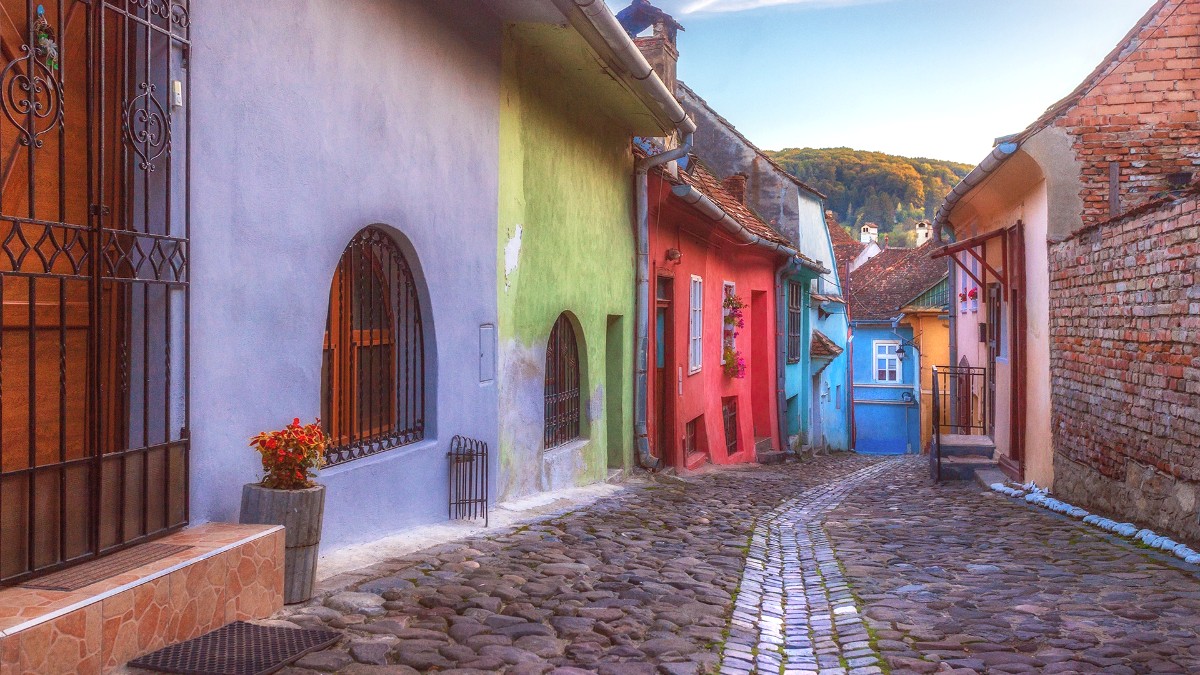
Transylvania, Romania
Imagine walking where Vlad the Impaler may have taken his first steps, or gazing upon the same landscapes that inspired legends. Sighisoara, one of Europe's last inhabited medieval fortresses, invites you to discover its charm, traditions, and enduring spirit. Prepare for an unforgettable experience where the past feels wonderfully present.
Sighisoara, known as Schäßburg in German and Segesvár in Hungarian, is a municipality positioned gracefully on the banks of the Târnava Mare River. This river, one of Transylvania's main waterways, shapes the valley where the lower, modern town extends. The city belongs to Mures County, a region in central Transylvania, Romania. The landscape here features rolling hills and dense forests, creating a picturesque setting that feels both ancient and secluded.
The city's unique topography contains two distinct parts. The medieval citadel, Cetatea Sighișoara, sits proudly atop a steep hill, offering a natural defensive advantage. This elevated position allowed its early inhabitants to survey the surrounding valley and guard valuable trade routes. Below, the lower town spreads out along the river valley. This separation highlights the city's historical development, with the fortified upper town serving as the commercial and administrative heart in medieval times, while the lower town grew to accommodate modern expansion and industry.
Sighisoara possesses a deep and layered history, beginning in the 12th century. Transylvanian Saxons, German colonists invited by the King of Hungary, founded the settlement. Their purpose: defend the border of the kingdom and develop the region's economy. These skilled artisans and merchants brought architectural styles and organizational structures that shaped Sighisoara into one of Transylvania's seven walled citadels, famously known as Siebenbürgen.
In recognition of its outstanding preservation and historical value, the Historic Centre of Sighisoara received UNESCO World Heritage Site designation in 1999. This honor highlights the city's role as a testament to the cultural traditions of the Transylvanian Saxons. Sighisoara also possesses a compelling association with Vlad III "the Impaler" Drăculea. Historical accounts suggest he was born here in 1431, though definitive proof remains elusive. This connection, popularized by Bram Stoker's Dracula, adds a layer of mystique and intrigue to the town. Regardless of exact historical accuracy, the story strengthens Sighisoara's identity as a place steeped in legend.
Transylvanian Saxons founded the settlement for border defense and economic growth.
Citadel gained economic importance; guilds built and maintained defensive towers.
Birth year of Vlad III "the Impaler" Drăculea (historical accounts suggest).
Historic Centre of Sighisoara received UNESCO World Heritage Site designation.
A living medieval fortress, preserving Saxon traditions and historical architecture.
Sighisoara's location within Transylvania places it conveniently near other major historical cities. Cluj-Napoca, a bustling university city, lies approximately 120 kilometers to the northwest. Brasov, a popular tourist destination, is about 90 kilometers south. Sibiu, another significant Saxon city, is around 80 kilometers west. These distances make Sighisoara a natural and accessible stop on any Transylvanian travel itinerary.
The region's geography, with its fertile river valleys, protective hills, and strategic passes, directly contributed to Sighisoara's growth as a fortified merchant town. The rivers supplied water and a means of transport for goods, while the surrounding hills offered resources and defense. This combination of natural features allowed Sighisoara to thrive as a center of trade and a stronghold against various invasions throughout its long history.
The well-preserved state of its towers and the original Saxon architecture show a direct link to a prosperous past. This commitment to preserving its heritage makes certain visitors experience the city as it existed centuries ago. The cobbled streets, colorful houses, and defensive structures present an authentic glimpse into medieval life that few other places can. This blend of verifiable Saxon history and captivating Dracula lore makes Sighisoara a place of endless fascination.
Sighisoara offers a compact yet profoundly enriching travel experience, easily understood through a quick overview of its core aspects.
Sighisoara offers a compact yet profoundly enriching travel experience, easily understood through a quick overview of its core aspects.
The city holds approximately 28,102 residents, according to the 2021 census. This number reflects the total municipality, encompassing both the historic citadel and the lower, modern town. The population leads to a comfortable, manageable size. You experience local life without the overwhelming rush of a larger metropolis. The modest population maintains a generally peaceful atmosphere, even during peak tourist seasons, outside the immediate hustle of the main square.
The medieval citadel, an UNESCO World Heritage site and one of Europe's best-preserved inhabited medieval fortresses.
Mainly medieval Saxon influences, with colorful houses, intricate details, and steeply pitched roofs.
A living testament to the history and traditions of the Transylvanian Saxons and a symbol of cultural resilience.
Several structures within Sighisoara's citadel are immediately recognizable and hold particular importance. The Clock Tower dominates the skyline and once served as the main gate. The Church on the Hill, a striking Gothic church, sits at the highest point. The Covered Stairway leads up to the Church on the Hill and the old school. These three features form the core of the citadel's identity.